At New York Comic Con this past weekend, Bandai Namco showed off Nanoblock, highlighting their Pokémon line of the tiny brick-building toy. Founded in 2008 in Japan, Nanoblock has since expanded overseas. The construction toy has won awards for its sets based on iconic locations, such as the 2010 deluxe edition of Neuschwanstein Castle. Since then, it has gained other licenses, including Dragon Ball and Gundam. For the Pokemon line it has around 70 sets.
The Nanosized World of Nanoblock
At the Nanoblock booth at Comic Con, I saw several finished Nanoblock creations on display and learned more about the building toy. The newest licenses consist of sets based on characters from Peanuts, Mega Man, and Godzilla. Popular brands on display also included sets recreating video game characters from Mega Man, Kirby, and Sonic the Hedgehog. One of the most popular individual sets depicts a cat drinking water from a bowl.
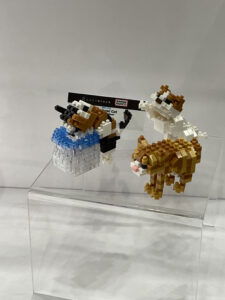
Though Nanoblock specializes in building tiny sets with its tiny blocks, it also offers larger ones consisting of many tiny blocks. Character-Nano, or CharaNano, recreate characters from popular anime in sets generally consisting of around 300 blocks. But even these come out on the lower end, with a Nanoblock New York City at 1,480 pieces and a Nanoblock Tokyo Train Station clocking in at 3,130 pieces.
And still, this pales in comparison to the giant Pacman Nanoblock on the convention floor. Last year for NYCC 2021, attendees could guess how many blocks comprised the massive Pacman, with a Pacman arcade cabinet going to the winner. And how many blocks make up the giant Pacman? Now that the contest is over, Bandai Namco can share that it is a whopping 51,300 pieces. It looks like Pacman ate a few fruits and maybe even gobbled up a few ghosts along the way.
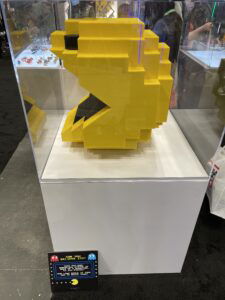
Aside from Pacman, Pokémon made up the big draw of the Nanoblock NYCC booth. The booth showcased many of the standard sets as well as the mini-sets, collections of tiny Pokémon grouped by type, such as fire or normal. But I had my eye on one standard Pokémon set in particular.
Lugia: The Guardian of the Seas
My first Pokémon game was Silver, so naturally, I had to choose Lugia for my first Pokémon Nanoblock set. It looks great with a nice symmetrical pose evoking its wings-spread sprite from the game. Consisting of 210 pieces, Lugia is one of the bigger and more complex Pokémon Nanoblock sets. Nanoblock marks its difficulty as three out of five. Generally, the Pokémon sets range from around 90 to 240 blocks with difficulties on the low-to-middle end of the spectrum.
While I often built LEGO sets as a kid, I had only limited familiarity with Nanoblock. While not as well known as the other building toy, Nanoblock has smaller pieces that can offer more of a challenge, as well as a smaller price point that can offer less of a challenge for your wallet. Otherwise, opening the set proved par for the course for any building toy. I found five bags of pieces and easy-to-follow instructions. The colors in the directions correspond well to their real-life counterparts. The step-by-step guide depicts already-assembled blocks in faded colors which help highlight the new ones added for each step.
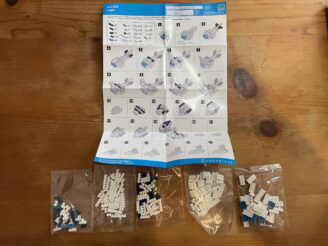
I’m the kind of person who enjoys a challenge and does not enjoy add-ons to lessen said challenge. So while the instructions recommend using the Nanoblock pad and tweezers, sold separately, I initially hesitated to use them. But I did find that each served a specific purpose.
Nanoblock figures are often built segment by segment. For example, Lugia has the body built, followed by its head, and then each of its wings, assembled together by the end. As such, I didn’t want to have to keep prying off segments stuck to the building pad. However, my worry proved unfounded. The highly flexible rubber of the Nanoblock pad keeps blocks in place while they get built and allows for easy removal.
As a perched flying creature, Lugia doesn’t have a massive footprint, nor do its specific segments. So I could’ve made do by keeping the bases in place without the pad, but it certainly helped. For Nanoblock figures with larger footprints, like Lapras or one of the city ones, I would highly recommend picking up the pad as well.
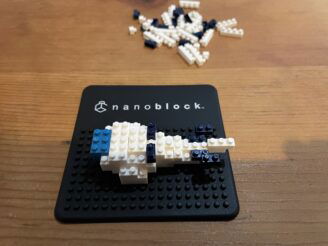
As for the tweezers, I didn’t need them at all for assembly. Disassembly? That’s another story. Now I didn’t mess up. Putting a block in the wrong place? Pshh, I’m a pro, I would never. Though I did decide to remove a block just to see if I could. I could not. But with the tweezers, it popped right off. I want to say that I, uh, loosened it first. But no, having tweezers really did make it doable. I imagine any old tweezers will do, though the Nanoblock ones do have the benefit of never having been in someone’s splintered finger or hairy nostril. I hope.
As for the build itself, I found it a nice middle-of-the-road challenge. The three-star level build occasionally required me to closely study the instructions to figure out what I had to add, especially early on. I found it the most satisfying after about 25 minutes in, once I had a general idea of what it was shaping up to look like and didn’t have to dig through quite as many blocks. Nanoblock are quite tiny, and I noticed that otherwise identical pieces sometimes have slight variations. I found one block that wouldn’t fit alongside the others, but thankfully the set came with several extra pieces.
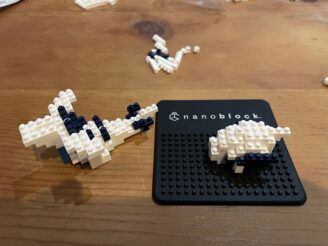
Specifically in regards to the Lugia set, I enjoyed the swooping aerodynamic design of the build. For the most part, the pieces anchor each other in a stabilizing and aesthetically pleasing way. The tail proves flimsy with its feathers, likely an unavoidable part of the design. As such, Lugia is a magnificent creature best admired from afar, not handled—just like the real Lugia (probably).
The primarily white design of Lugia provided much of the challenge since I had to differentiate pieces by size, not color. Next time I’ll likely go for a more colorful Pokémon, but I enjoyed this set’s elegant and uncluttered finalized look. I realize that unlike the intricate cities and temples that make up the flagship Nanoblock sets, Pokémon ones cater to the constraints of the original game designs. But still, I could’ve opted for the colorful Ho-Oh or robust Snorlax, but Lugia is a favorite and I do love the about-to-take-flight look of the finished set.
Let’s be honest, most people will get Pokémon Nanoblock to build their favorite pocket monster. At the same time, if you’re deciding between a few, it’s worth taking color, design, challenge, and pose into play. Lugia lags slightly behind in the former two, but excels in the latter qualities.
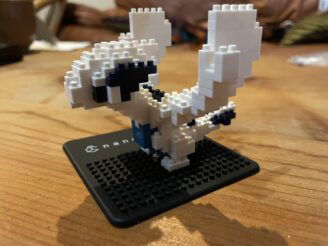
Overall, I enjoyed my time with the Lugia Nanoblock set and am pleased with the final result. The set took me just under an hour and 40 minutes to build, a solid amount of time for the 210 piece set. I’ll fess up now. I did make a mistake while building Lugia’s neck. So the tweezers proved invaluable there but otherwise I didn’t need them. Likewise, the Nanoblock pad helped stabilize the bases of each segment, and also made a good stand to display the finished set. It’s not mandatory—unless you’re building Nanoblock on a train or plane ride, in which case the extra pieces will likely come in handy for those you lose—but it did prove helpful.
I would definitely build more Nanoblock in the future, likely selecting a non-Pokémon set for my next one, possibly a more intricate city or temple set. But I can see the allure of getting as many Pokémon sets as possible. After all, for some people, you gotta build ’em all.


